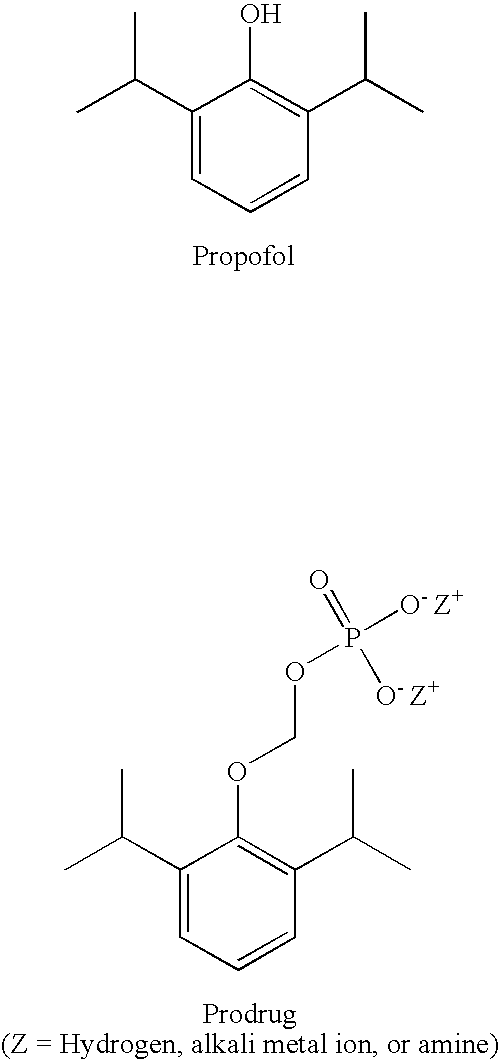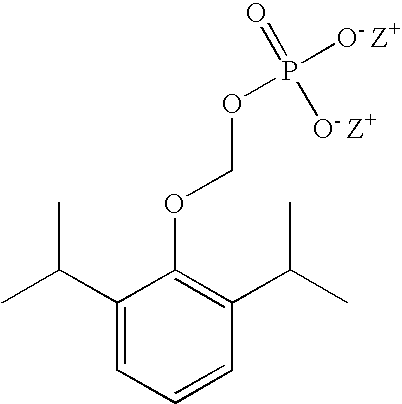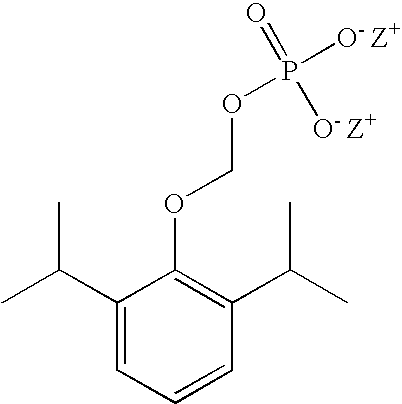Aqueous based pharmaceutical formulations of water-soluable prodrugs of propofol
a technology of propofol and pharmaceutical formulations, which is applied in the field of injectable anesthetic agents, can solve the problems of limited shelf life, postsurgical infections, and the inability to detect bacterial or fungal contamination by visual inspection of the vial
- Summary
- Abstract
- Description
- Claims
- Application Information
AI Technical Summary
Benefits of technology
Problems solved by technology
Method used
Image
Examples
example 1
[0030]This example illustrates that the degradation of O-phosphonooxymethyl propofol is pH dependent. In particular, higher pH conditions generally result in lower rates of hydrolysis (degradation) of the prodrug, while lower pH conditions increase the rate of hydrolysis. At a pH of about 9-9.5, which is suitable for intravenous injection, the least amount of hydrolysis is observed at accelerated stability conditions of 40° C., 75% RH. Table II illustrates the formation of propofol (DIP) over a range of pH conditions.
TABLE IIDIP formation (% w / v) at AcceleratedStability Conditions (40° C. / 75% RH)TimepH 6.9pH 7.4pH 8.0pH 8.5pH 9.1pH 9.91 month1.220.830.320.15NMTNMTLOQLOQ(0.05%)(0.05%)3 months1.900.670.760.410.12NMTLOQ(0.05%)6 months3.472.140.720.730.220.09NMT LOQ = not more than limit of quantitation
example 2
[0031]This example illustrates the color formation as a function of pH in O-phosphonooxymethyl propofol formulations containing an antioxidant, as described in WO 2003 / 057153 A2. Table III shows that a formulation prepared at pH 8.5 remained colorless after 6 months. Since even lower amounts of DIP are generated at pH>8.6, it was discovered that stable aqueous formulations can be prepared at pH>8.6 without requiring an antioxidant.
TABLE IIIImpact of pH on Color Formation at Accelerated Stability ConditionsTimepH 6.9pH 7.4pH 8.0pH 8.5pH 9.1pH 9.91 monthPalePaleColorlessColorlessColorlessColorlessYellowYellow3 monthsPaleVeryVeryColorlessPaleColorlessYellowpalepaleYellowYellowYellow6 monthsVeryVeryVeryColorlessColorlessColorlesspalepalepaleYellowYellowYellow
example 3
[0032]This example illustrates the stability of an O-phosphonooxymethyl propofol (40 mg / mL) formulation prepared without antioxidant. The formulation contained 0.12% (w / v) 2-amino-2-hydroxymethyl-1,3-propanediol and 10 mmol sodium bicarbonate (pH 9.0-9.3). As illustrated in Table IV below, under accelerated stability conditions (40° C., 75% RH) the formulation remained colorless after 3 months storage and pH remained substantially constant.
TABLE IVStability of Antioxidant-free Formulationat Accelerated Stability ConditionsTimeAppearancepH0Clear, Colorless9.311 weeksClear, Colorless9.272 weeksClear, Colorless9.274 weeksClear, Colorless9.315 weeksClear, Colorless9.346 weeksClear, Colorless9.348 weeksClear, Colorless9.3912 weeks Clear, Colorless9.29
PUM
| Property | Measurement | Unit |
|---|---|---|
| Substance count | aaaaa | aaaaa |
| Volume | aaaaa | aaaaa |
| Volume | aaaaa | aaaaa |
Abstract
Description
Claims
Application Information
 Login to View More
Login to View More - R&D
- Intellectual Property
- Life Sciences
- Materials
- Tech Scout
- Unparalleled Data Quality
- Higher Quality Content
- 60% Fewer Hallucinations
Browse by: Latest US Patents, China's latest patents, Technical Efficacy Thesaurus, Application Domain, Technology Topic, Popular Technical Reports.
© 2025 PatSnap. All rights reserved.Legal|Privacy policy|Modern Slavery Act Transparency Statement|Sitemap|About US| Contact US: help@patsnap.com



